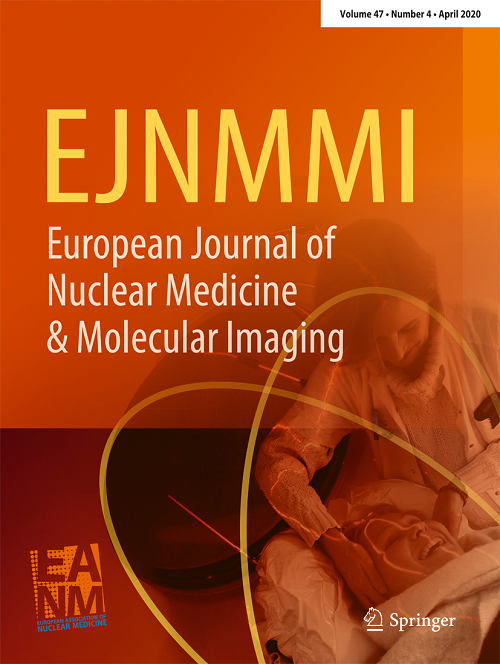经典霍奇金淋巴瘤患者代谢性肿瘤负担与健康相关生活质量的关系
IF 7.6
1区 医学
Q1 RADIOLOGY, NUCLEAR MEDICINE & MEDICAL IMAGING
European Journal of Nuclear Medicine and Molecular Imaging
Pub Date : 2025-10-11
DOI:10.1007/s00259-025-07569-5
引用次数: 0
摘要
【18F】氟脱氧葡萄糖正电子发射断层扫描/计算机断层扫描(PET)分期是经典霍奇金淋巴瘤(cHL)的标准治疗方法。代谢肿瘤体积(MTV)是肿瘤负荷的定量生物标志物,已被证明可以预测治疗反应。本研究探讨了不同疾病阶段PET基线时的MTV与健康相关生活质量(HRQoL)之间的关系。方法:这项事后分析包括441例新诊断的cHL患者和可用的基线PET成像,纳入GHSG试验HD16、HD17和HD18。通过LifeX Analytics工作站,使用SUV≥4.0 (SUV4.0)的固定阈值对MTV进行量化。HRQoL在基线时使用EORTC QLQ-C30问卷进行评估,对于HD18患者,再次进行2年随访。采用校正性别、年龄和试验/阶段的多元回归模型进行统计分析。结果较高的MTV与多个领域较高的基线HRQoL负担相关:疲劳(β = 0.14, 95% CI[0.05; 0.24])、呼吸困难(β = 0.21, 95% CI[0.11; 0.30])、食欲减退(β = 0.13, 95% CI[0.03; 0.23])和睡眠障碍(β = 0.12, 95% CI[0.02; 0.22])。相反,较高的MTV与身体功能(β = -0.18, 95% CI[-0.27; -0.08])和整体健康状况(β = -0.15, 95% CI[-0.25; -0.06])呈负相关。在晚期疾病(HD18)患者中观察到最强的相关性。在HD18的2年随访中,除了疼痛之外,基线MTV与HRQoL之间没有关联,疼痛仍然是唯一相关的领域(β = 0.15, 95% CI[0.00; 0.30])。结论:基线MTV与新诊断cHL患者治疗前的HRQoL密切相关,尤其是晚期cHL患者。令人欣慰的是,在康复的第二年内,初始疾病负担似乎对HRQoL没有重大影响。临床试验注册网站:HD16 (NCT00736320;首次发布于2008年8月15日),HD17 (NCT01356680;首次发布于2011年5月19日),HD18 (NCT00515554;首次发布于2007年8月13日)。本文章由计算机程序翻译,如有差异,请以英文原文为准。
Association between metabolic tumor burden and health-related quality of life in patients with classic Hodgkin lymphoma.
INTRODUCTION
Staging with [18F]fluorodeoxyglucose positron emission tomography/computed tomography (PET) is standard of care in classic Hodgkin lymphoma (cHL). Metabolic tumor volume (MTV) is a quantitative biomarker of tumor burden and has been shown to predict treatment response. This study investigates the association between MTV at baseline PET and health-related quality of life (HRQoL) across different disease stages.
METHODS
This post-hoc analysis included 441 patients with newly diagnosed cHL and available baseline PET imaging, enrolled in the GHSG trials HD16, HD17, and HD18. MTV was quantified using a fixed threshold of SUV ≥ 4.0 (SUV4.0) via the LifeX Analytics workstation. HRQoL was assessed using the EORTC QLQ-C30 questionnaire at baseline and, for HD18 patients, again at 2-year follow-up. Multiple regression models adjusted for sex, age, and trial/stage were used for statistical analyses.
RESULTS
Higher MTV was associated with higher baseline HRQoL burden across several domains: fatigue (β = 0.14, 95% CI [0.05; 0.24]), dyspnea (β = 0.21, 95% CI [0.11; 0.30]), appetite loss (β = 0.13, 95% CI [0.03; 0.23]), and sleep disturbance (β = 0.12, 95% CI [0.02; 0.22]). In contrast, higher MTV was negatively associated with physical functioning (β = -0.18, 95% CI [-0.27; -0.08]) and global health status (β = -0.15, 95% CI [-0.25; -0.06]). The strongest associations were observed in patients with advanced-stage disease (HD18). At 2-year follow-up in HD18, no associations between MTV at baseline and HRQoL were found, with the exception of pain, which remained the only associated domain (β = 0.15, 95% CI [0.00; 0.30]).
CONCLUSION
Baseline MTV is strongly associated with HRQoL before therapy in patients with newly diagnosed cHL, particularly in those with advanced-stage disease. Reassuringly, there seems to be no major influence of initial disease burden on HRQoL within the second year of recovery.
TRIAL REGISTRATION
ClinicalTrials.gov: HD16 (NCT00736320; first posted August 15, 2008), HD17 (NCT01356680; first posted May 19, 2011), HD18 (NCT00515554; first posted August 13, 2007).
求助全文
通过发布文献求助,成功后即可免费获取论文全文。
去求助
来源期刊
CiteScore
15.60
自引率
9.90%
发文量
392
审稿时长
3 months
期刊介绍:
The European Journal of Nuclear Medicine and Molecular Imaging serves as a platform for the exchange of clinical and scientific information within nuclear medicine and related professions. It welcomes international submissions from professionals involved in the functional, metabolic, and molecular investigation of diseases. The journal's coverage spans physics, dosimetry, radiation biology, radiochemistry, and pharmacy, providing high-quality peer review by experts in the field. Known for highly cited and downloaded articles, it ensures global visibility for research work and is part of the EJNMMI journal family.

 求助内容:
求助内容: 应助结果提醒方式:
应助结果提醒方式:


